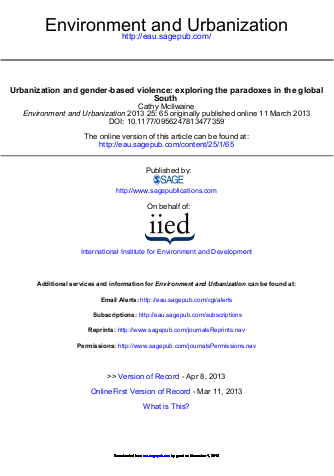
This paper examines the nature and paradoxes of the relationship between urbanization and gender-based violence, especially violence against women. It highlights how such violence varies according to geographic scale as well as a range of other causal and contextual processes in cities of the global South. The discussion highlights that while the underlying causes of gender- based violence rooted in patriarchal relations are ubiquitous across place, certain “triggers” or “risks” can lead to variations between urban and rural areas. However, it also argues that the existing data on gender-based violence makes it extremely difficult to make any accurate comparison between cities and the countryside and therefore it is more helpful to focus on the relationships between urbanization and gender-based violence. On the one hand, cities provide women with greater opportunities to cope with violence more effectively in relation to tolerance, access to economic resources and institutional support. Yet on the other hand, social relations can be more fragmented, which can lead to greater incidence of violence as can the pressures of urban living, such as poverty, engagement in certain types of occupation, poor quality living conditions and the physical configuration of urban areas. Ultimately, cities themselves do not generate gender-based violence, and opportunities for reducing it can be enhanced in urban areas.
Resource collections
- Accountability to affected populations (AAP)
- UN Habitat - Urban Response Collection
- Urban Response - Urban Crisis Preparedness and Risk Reduction
- Urban Response Collection - Community Engagement and Social Cohesion
- Urban Response Collection - Economic Recovery
- Urban Response Collection - Environment and Climate Change
- Urban Response Collection - Housing, Land and Property
- Urban Response Collection - Urban Crisis Response, Recovery and Reconstruction
- Urban Response Collection - Urban Resilience